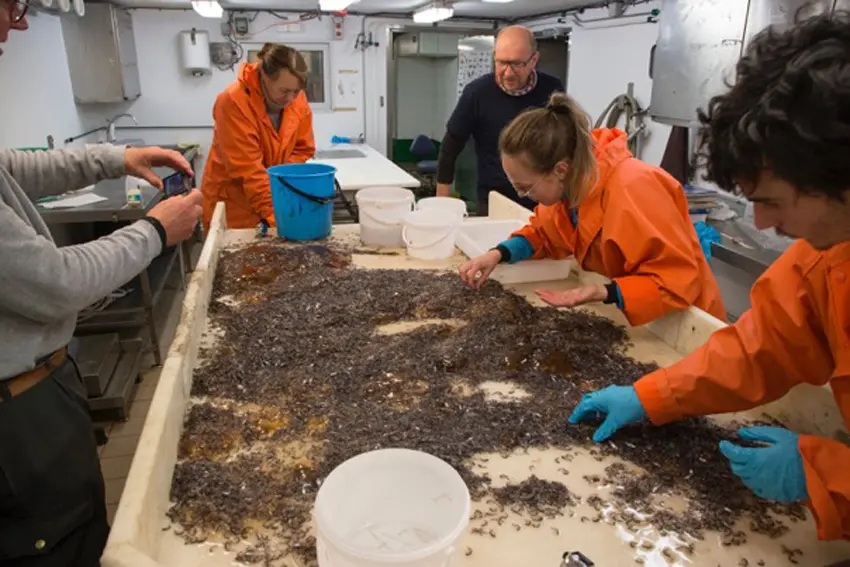Stories from Rijpfjorden 3: Monster!

Top image: The monster from the depths! Photo: Jonas Thormar.
Fortunately, it is no bigger than 5–6 cm; otherwise it would have been a really scary sight. It is found mostly throughout the whole Arctic, and is a species we count as an indicator of cold water masses. And for all the smaller organisms, such as Calanus finmarchicus and Calanus glacialis, it is a ferocious monster!
30 October 2018
Text: Professor Jørgen Berge (UiT The Arctic University of Norway, UNIS and NTNU) and Professor Stig Falk-Petersen (Akvaplan-niva and UiT The Arctic University of Norway) and Professor Paul Renaud (Akvaplan-niva and UNIS).
Themisto libellula is one of the most important and dominant species we find in the Arctic. The name probably comes from the group of insects called ‘øyenstikker’ in Norwegian (dragonfly in English), but in German is called ‘libelle’ and in French ‘libellule’.
Beyond a certain superficial resemblance and its name, it has little in common with dragonflies. Themisto libellula is a crustacean belonging to the group amphipods, but lives in the free water masses. It can often occur in large swarms, and is a much sought after prey for the polar cod for instance. In Rijpfjorden, these two are the rulers, the Themisto libellula in the upper water masses and the polar cod in the lower water masses.
Ferocious predator
Themisto libellula is perhaps the most ferocious predator found in the Arctic Ocean. In the fjords and on the continental shelf around Svalbard, it is notoriously looking for Calanus finmarchicus and Calanus glacialis, while in the more central parts of the Arctic Ocean it feeds on the sought after Calanus hyperboreus. And as for us all (unfortunately …), the rule of thumb “you become what you eat,” applies to the highest degree for the Themisto libellula. Its diet consists of up to 60–70% fat. The Themisto libellula is therefore very fat, at least in the autumn, which makes it a popular prey for many other predators, such as fish, seals and seabirds.
“You become what you eat” applies not only to fatness, but also to the way the body is composed. Taking samples of fat and muscles from an animal (and humans for that matter) allows you to analyze the chemical composition to determine what food the animal has eaten. When such analyzes is performed on Harp seals, you will find a clear signature of the Themisto libellula. Stomach samples from polar cod tell the same story; when available, the Themisto libellula is the favorite.
To illustrate how gluttonous the Themisto libellula can be, we must confess to a mistake we made a few years ago on a cruise north of Svalbard. We had collected a large sample of zooplankton consisting mainly of Themisto libellula and Calanus finmarchicus. We left the bucket with zooplankton on deck while we had lunch. When we returned, it was not just we who had eaten lunch … the bucket suddenly consisted only of Themisto libellula!
Large amounts
On our trip to Rijpfjorden in August this year, we conducted both acoustic surveys of the amount of zooplankton and took net- and trawl samples to establish what species are present in the fjord. Disregarding jellyfish, the proportion of Themisto libellula represented more than 95% of the zooplankton. This was a joyful sight (at least for us, maybe not as much for the Calanus finmarchicus), since there has been little Themisto libellula in Rijpfjorden over the last 3–4 years.
When such an important species disappears or decreases significantly, it is likely that it will have consequences for the rest of the food chain. Themisto libellulais probably an arctic species that typically changes distribution according to the climate. In the Barents Sea, for example, we see the species has wandered significantly further north than was the case 10–20 years ago. How and why the distribution changes so much in the Svalbard fjords, and especially in a cold fjord like Rijpfjorden, is something we still know too little about. But luckily for the polar cod, seals and seabirds that live all or part of the year in Rijpfjorden, it was at least back this year!
